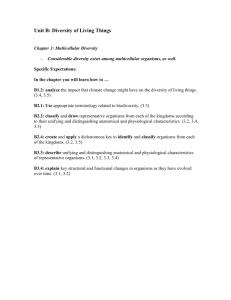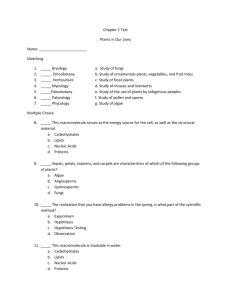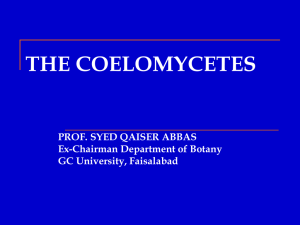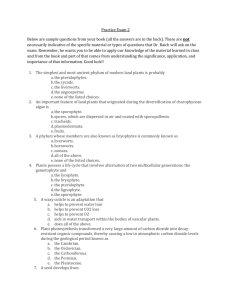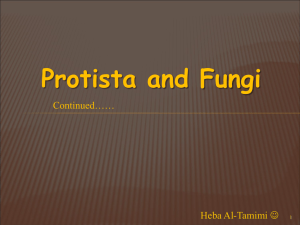Botany
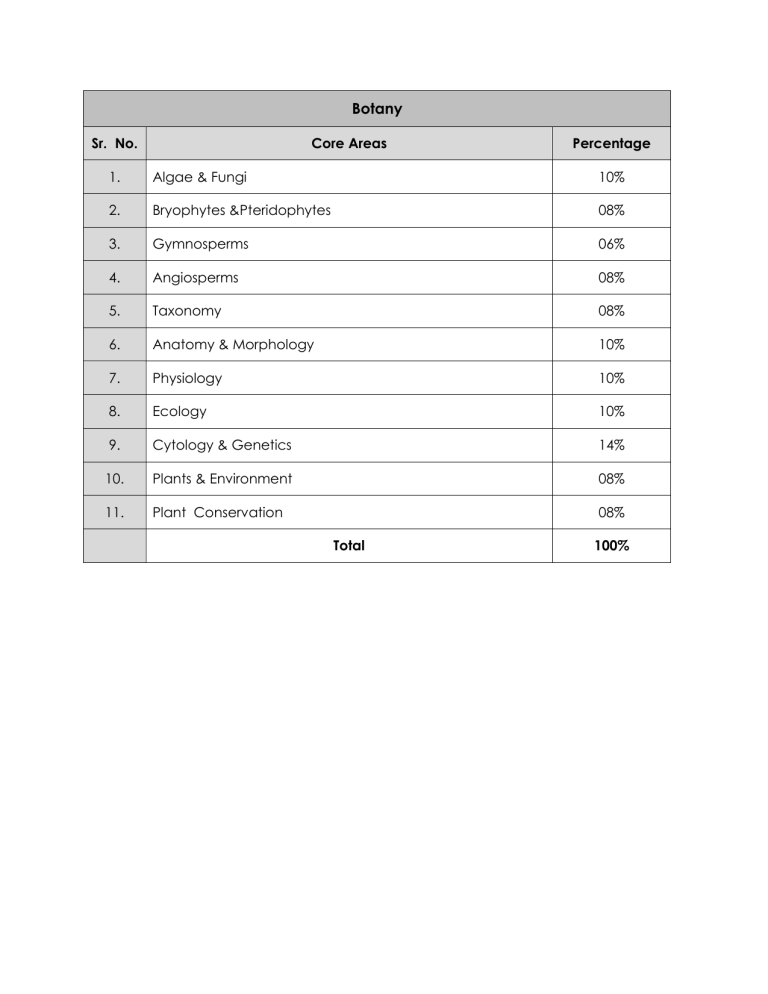
Botany
Sr. No.
1. Algae & Fungi
2.
3.
Core Areas
Bryophytes &Pteridophytes
Gymnosperms
4.
5.
6.
Angiosperms
Taxonomy
Anatomy & Morphology
7.
8.
Physiology
Ecology
9. Cytology & Genetics
10. Plants & Environment
11. Plant Conservation
Total
Percentage
10%
08%
06%
08%
08%
10%
10%
10%
14%
08%
08%
100%
Botany (Detailed)
Sr. No.
1.
Core Areas
ALGAE & FUNGI:
Introduction, general account, morphology, cell structure, reproduction, life cycle and evolution in
Algae (Chlamydomonas, Spirogyra, Chara,
Vaucheria, Pinnularia, Ectocarpus and Polysiphonia).
Modern classification upto order levels with general examples (Phylum Cyanophyta, Prochlorophyta
(Kingdom Monera); Glaucophyta; Volvocophyta;
Euglenophyta; Dinophyta; Cryptophyta;
Chrysophyta; Prymnesiophyta; Bacillariophyta;
Xanthophyta; Eustigmatophyta; Raphidophyta and
Porphyridiophyta (Kingdom protista); Chlorophyta;
Charophyta; Vauchariophyta; Phaeophyta and
Rhodophyta (Kingdom Protoctista), A general survey, distribution and identification of green and brown seaweeds along the coast.
Mineral nutrition of algae: Role, importance and function of major and minor elements. Role of organic factors and vitamins in algal growth. Algal pigments: chloroplast, its ultra structure and molecular organization. Role of algal pigments, distribution and chemical composition. Orientation of pigments in chloroplast. Photosynthesis: Fixation and path of carbon in photo-assimilation of organic substances and mechanism of photo-reduction in algae. Respiratory metabolism in algae: Brief account of Krebs cycle and the mechanism of oxidative and substrate linked phosphorylation in algae. Brief account of Glycolysis and its importance in cellular metabolism. Nitrogen metabolism:
Nitrogen fixation, Nitrogen assimilation and Protein synthesis. Nitrogen fixation in Blue green algae;
Heterocystous, non-heterocystou, filamentous and unicellular. A brief account of various types of movement and rhythm commonly found in algae.
Ecology of algae, their distribution & zonation in relation to climatic factors. Utilization of seaweeds in industries. Utilization of seaweeds as food for human consumption, fertilizer, fodder and in medicine &
Percentage
10%
cosmetics. Preparation and uses of major compounds like: Agar-Agar, Alginic acid and
Carrageenan obtained from brown and red seaweeds. Economic importance of the following divisions of algae: Chlorophyta, Charophyta,
Xanthophyta, Baciloariophyta, Pheophyta and
Rhodophyta.
1.1 Introduction:
General characteristics, Structure, Reproduction
(sexual and asexual) and Diversity of fungi.
Systematics of Fungi and Fungi like organisms.
1.2 Kingdom Protista (Protoctista):
Phylum Myxomycota (Steminites), Phylum
Plasmodiophoromycota (Plasmodiophora
brassiceae), Phylum Acrasiomycota, Phylum
Dictyosteliomycota.
1.3 Kingdom Straminopila:
Phylum Hyphochytriomycota, Phylum
Labrinthulomycota.
1.4 Phylum Oomycota:
{Phytophthora infestans (late blight of potato), Phythium, Albugo, Peronospore,
Plasmopara}.
1.5 Kingdom Fungi:
Phylum Chytriomycota (Synchytrium endobioticum),
Zygomycota (Rhizopus).
1.6 Phylum Ascomycota: i) Saccharomycetes (Yeast). ii) Archaeascomycetes (Taphrinia).
iii) Discomycetes (Peziza). iv) Pyrenomycetes (Erysiphe(Powdery mildew), Venturia). v) Loculoascomycetes (Claviceps).
1.7 Phylum Basidiomycota:
i) Ustilaginomycetes: Ustilago (Smut fungi)
ii) Urediniomycetes: Puccinia (Rust fungi) iii) Hymeniomycetes: Agaricus(Mushroom).
1.8 Phylum Deuteromycota:
Penicillium and Aspergillus, Alternaria, Root-rot
causing imperfect fungi.
Symbiotic Association of fungi with other organisms:
Lichens & Mycorrhiza
Symptoms and development of plant diseases caused by fungi and scontrol of fungal diseases.
Economic importance, use of fungi in Agriculture & biotechnology.
2.
3.
BRYOPHYTES & PTERIDOPHYTES:
Introduction and general account of bryophytes, classification, theories of origin and evolution. Brief study of the classes: Hepaticopsida, Anthoceropsida and Bryopsida. Comparative study of life form, structure, reproduction and economic significance of Bryophytes (Riccia,
Anthoceros, Funaria and Polytricum).
Porella,
Introduction, origin, history, features and a generalized life cycle of pteridophytes. Fossils and fossilization, methods of fossilization, types of fossils, geological time scale and importance of paleobotany. First vascular plant – Rhyniophyta e.g. Rhynia. Seed habit, general characteristics, classification, affinities and comparative account of evolutionary trends of the following phylla:
Psilophyta, (Psilotum), Lycophyta
(Lycopodium and Selaginella),
(Equisetum), pteridosperms.
Pterophyta
Sphenophyta
(Ophioglossum,
Dryopteris and Azolla / Marsilea). Introduction to
GYMNOSPERMS:
Comparative study of life form, structure, reproduction and economic significance of Cycas,
Pinus and Ephedra. Geological history, origin, distribution, morphology, classification affinities and anatomy (stem, petiole, leaf, roots and reproductive parts) of Cycadofillicales, Bennettitales, Ginkgoales,
Cycadales, coniferales, Gnetales. Pollination and
Post pollination development of gametophytes,
Embryology and affinities of Cycadales), Coniferales
(anatomy of stem, leaf, roots, reproductive parts;
Male and Female cones); Pollination and
08%
06%
7.
8.
5.
6.
4. development of male and female gametophytes;
Fertilization and development of Embryo in
Coniferales and Gnetales. Pollination and development of gametophytes. Origin and evolution of seed habit. Distribution of gymnosperms in
Pakistan. An introduction of the Gondwana flora of world. Comparison of Life Cycles of Pinaceae with
Cupressaceae and affinities of Coniferales.
Economic Importance of Gymnosperms of Pakistan.
ANGIOSPERMS:
Origin of angiosperms, Evolution of fruit habit. Plant body and its development: Fundamental parts (i.e.
Root, stem and leaves) of the plant body. Internal organization, different tissues and tissue system of primary and secondary body. Morphological and anatomical adaptations. History of
Embryology. Structure and development of Anther
(Microsporangium): Anther wall, its development and ultra structure of anther wall, endothecium middle layers, tapetum. Microsporogenesis, rare features. Male Gametophyte: Morphology of Pollen grains, Development of Pollen walls, Pollen wall features, scope of Palynonlogy. Develeopment and morphology of male gametophyte and abnormalities. Pollination; Fertilization; Sexual incompatability. Endosperm: Formation, Types,
Function, abnormalities, Histology of Endosperm,
Xenia, Metaxenia and Mosiac endosperm. Ovule
(Megasporangium): Morphology, structure, types and parts of ovule, development, morphology and types of female gametophyte. Embryo:
Embryogeny, Embryonic laws, Embryonic formulae,
Types of Embryo, unclassified and Abnormal Embryo,
Apomixis. Seed: Formation and Types.Embryology in relation to Taxonomy. Experimental and applied embryology. Megasporogenesis, Parthenocarpy and
Polyembryony
.
TAXONOMY:
ANATOMY & MORPHOLOGY:
PHYSIOLOGY:
ECOLOGY:
08%
08%
10%
10%
10%
9. CYTOLOGY & GENETICS:
10. PLANTS & ENVIRONMENT:
11. PLANT CONSERVATION
Total
14%
08%
08%
100%
